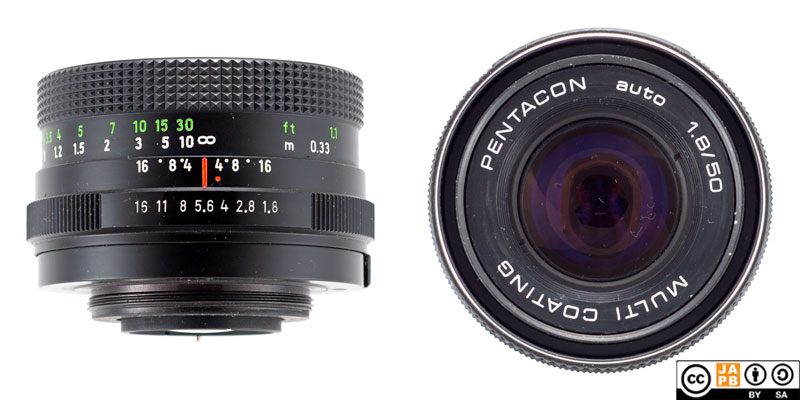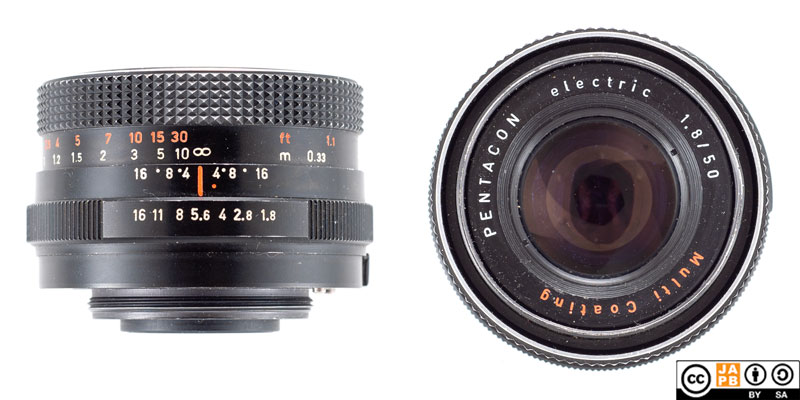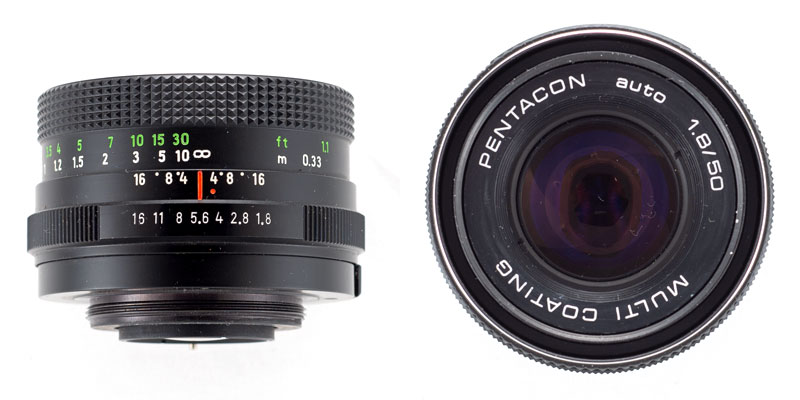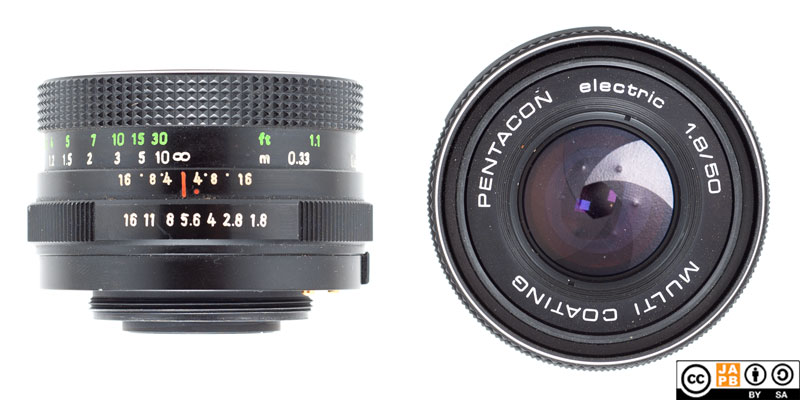Pekka Buttler, 11/2022 (Updated 08/2025)

Specifications
The table below summarises the lens’ key specifications (measurements based on 4th gen auto variant, but other pictured variants barely1 differ):
| Brand: | Pentacon | Lens name | auto 1.8/50 multi coating |
| Focal length(s) 2 | 50 mm | Angle-of-view 3 | 47 ° |
| Maximum Aperture | f/1.8 | In Production | 1970-1990 (all versions together) |
| Lens mounts | m42 (auto/electric) | Subfamily (if applicable) | –– |
| Length 4 | 39,3 mm | Diameter 5 | 64,2 mm |
| Filter ring diameter | 49 mm | Weight | 193 grams |
| Lens element count | 6 | Lens group count | 4 |
| Aperture blades (S/R/C) 6 | 6 S | Focus throw | 330 ° |
| Minimum focusing distance | 33 cms | Maximum magnification | 1:4,4 |
| Has manual aperture ring | YES | Has Manual focus ring | YES |
Further notes:
• The Pentacon 50/1.8 is the successor of the Meyer-Optik Görlitz Oreston 50/1.8.
• The Pentacon 50/1.8 was offered as the kit lens with countless numbers of Praktica L series cameras, making the Pentacon 50 one of the top-10 most produced lenses of all time.
• This data sheet covers both the ‘auto’ and ‘electric’ variants of the m42 mount Pentacon 50/1.8. The Pentacon Prakticar 50/1.8 is covered separately [data sheet]
• While most of the lenses that were offered as ‘Pentacon’ lenses starting from ≈1970 were based on earlier optical designs of same-spec Meyer lenses, the Pentacon 50/1.8 actually is a somewhat tweaked optical design (see schematic comparison below).

Versions
I’ll admit this is a bit complicated…
Firstly, Pentacon/Praktica cameras used two variants of the M42 mount,
• one was the classic m42 auto mount (pin at the bottom of the lens for stopping down). These lenses were generally indicated by the phrase ‘auto’ on the lens’ name ring.
• the other was Pentacon’s proprietary m42 variant which used electric contacts to communicate set aperture values to the camera, but still used the same m42 auto pin for stopping down. These lenses were generally indicated by the phrase ‘electric’ on the lens’ name ring.
Having been manufactured for ≈20 years, there are several ergonomically and outwardly different models of the Pentacon 50/1.8. Furthermore, Pentacon (as well as MOG before them) often tended to – when possible – use up parts stocks, meaning that one can also encounter hybrids.
• Early, 1st generation models lacked multi-coating (indicated by the lack of either ‘MC’ or ‘multi coating’ on the lens’ name ring. These models would also typically have some zebra-like cosmetically elements, aperture values would be in black against a metallic background and distance values in feet were in red. The focus ring would be a milled metal ring. These lenses would not have an auto/manual switch but instead offered a button for DOF preview 7.
• 2nd generation models would be all-black, still have the feet indications in red, still have the DOF preview button, still not offer multi-coating, but the shape of the metal focusing ring would have changed from being lengthwise ribbed to a checkered pattern.
• 3rd generation models would outwards look like 2nd generation models, but would instead sport an auto/manual switch and offer multi-coating. (See below).

• 4th generation models would be very similar to 3rd generation models, but the color of the feet-indication would switch to green, and the typography of the name ring would change [See below for a 4th generation auto variant]


• a 5th generation made its appearance toward the end of the production run (from mid 80s onward) where the checkered pattern would change to a lengthwise elongated shape (see below).

I’ve seen exemplars of all variants 1–4 having been available in both m42 auto and m42 electric variants.
History of Pentacon
Pentacon – more precisely VEB Pentacon – was an East German state-owned camera and optics combinate that was very influential (also outside the East Bloc) from its inception until the demise of the East German people’s republic.
But Pentacon was not born out of thin air. Therefore any real appreciation of Pentacon – either as a camera maker or as an optics manufacturer – has to start with a back story. Read more in the JAPB company profile on Pentacon …
Adapting
This lens cannot be used natively on any current SLR or dSLRs. To use it in its native environment, you will need an m42-mount film body. Luckily there are a lot of those available and in working order.
Thanks to being a fully manual lens (manual aperture, manual focus), the lens can be adapted to all mirrorless cameras using a suitable adapter. Moreover, m42 lenses are so uncomplicated that a simple ‘dumb adapter’ will do the job perfectly. Further, due to the popularity of the m42 mount, special adapters (helicoid adapters, tilt/shift adapters) are readily available. Alternatively, one can choose to daisy-chain adapters (e.g. m42->Canon EF; Canon EF –> mirrorless) which also opens up a wide range of speed boosters .
Using m42 lenses on dSLRs can also be an easy option, depending on which dSLR.
• Canon EF has the shortest flange focal distance among full-frame dSLR’s and Canon’s wide range of dSLRs are able to mount m42 lenses perfectly, using a simple adapter ring.
• Minolta / Sony A dSLRs and Pentax dSLRs are likewise able to mount m42 lenses using a simple adapter ring.
• Nikon F dSLRs have a long flange focal distance, meaning that mounting either M42 or Exakta lenses needs an adapter that uses corrective optics to allow anything close to infinity focus.
Footnotes
- Of the pictured variants, the electric samples seem to weigh ca. 4 grams more than the automatic variants. All other measurement differences between 3rd and 4th generation auto and electric variants are so small that they might be measurement errors. Sadly I do not have any 1,2 or 5th generation samples on hand. ↩︎
- Focal length is (unless stated otherwise) given in absolute terms, and not in Full-frame equivalent. For an understanding of whether the lens is wide/tele, see ‘Angle-of-view’. ↩︎
- Picture angle is given in degrees (based on manufacturers’ specs) and concerns the diagonal picture angle. Rule of thumb:
> 90 ° ==> Ultra-wide-angle
70–90 ° ==> Wide-angle
50–70 ° ==> Moderate wide-angle
40–50 ° ==> ‘Standard’ or ‘normal’ lens
20–40 ° ==> Short tele lens
10-20 ° ==> Tele lens
5-10 ° ==> Long tele lens
< 5 ° ==> Ultra-tele lens ↩︎ - Length is given from the mount flange to the front of lens at infinity. ↩︎
- Diameter excludes protrusions such as rabbit ears or stop-down levers. ↩︎
- S=straight; R=rounded; C=(almost)circular at all apertures. ↩︎
- Some, likely very early 1st generation lenses would be called Pentacon Oreston, but this hybrid naming is very rare. ↩︎